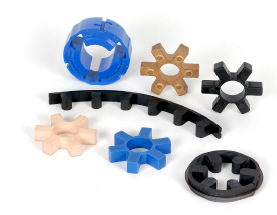Elastomers In Compression
We gives 4 types of elastomer styles to permit for additional flexibility in addressing certain application needs. 1 piece styles are utilized in the “L” and “AL” models (called spiders) and a  number of component “load cushions” are used in the “C” and “H” model couplings. The load cushions are in sets of six to 14 pieces based on coupling size.
number of component “load cushions” are used in the “C” and “H” model couplings. The load cushions are in sets of six to 14 pieces based on coupling size.
Sound Center Spider
The sound center style is typically made use of style and design when shafts on the driver and driven tools is usually kept separate by a typical gap
Open Center Spider
The open center design and style will allow for the shafts with the driver and driven to be positioned inside a brief distance
Open center spiders present shaft positioning flexibility but possess a reduce RPM capability
Cushions
Applied solely for that C and H Kind couplings
Load cushions are held in spot radially by a steel collar that's connected to on the list of hubs
Snap Wrap Flexible Spider
Style will allow for quick elimination on the spider without moving the hubs
Allows for shut shaft separation each of the way up to the hubs optimum bore
Optimum RPM is one,750 RPM using the retaining ring, but if utilised together with the LC Sort (with collar) the typical RPM rating on the coupling applies
Fashion is accessible in NBR and Urethane only, and in restricted sizes
Spider Products
SOX (NBR) Rubber
The normal materials that may be hugely flexible materials that is certainly oil resistant
Resembles organic rubber in resilience and elasticity, and operates proficiently in temperature ranges of -40° to 212° F (-40° to 100° C)
Urethane
Has one.five occasions greater torque capacity than NBR
Fantastic resistance to oil and chemical compounds
Material delivers less dampening result and operates at a temperature selection of -30° to 160° F
Hytrel
Versatile elastomer intended for large torque and large temperature operations
Operates in temperatures of -60° to 250° F (-51° to 121° C)
Bronze
Rigid, porous, oil-impregnated metal insert exclusively for lower velocity (max 250 RPM) applications requiring high torque abilities
Not affected by water, oil, dirt, or extreme temperatures - operates in temperatures of -40° to 450° F (-40° to 232° C)